Surrounding Rock Stability Control Technology of Roadway in Large Inclination Seam with Weak Structural Plane in Roof
Abstract
:1. Introduction
2. Deformation and Failure Characteristics and Instability Mechanism of Surrounding Rock of Roadway in Steep Seam
2.1. Background
2.2. Establish the Numerical Calculation Model
2.3. Analysis of Simulation Results
2.4. Analysis on Failure Characteristics of Roadway in Steep Coal Seam
3. Mechanical Mechanism of Stability of Roadway Roof with Large Inclination under Support Failure
3.1. Establishment of Mechanical Model
3.2. Influence of Support Strength on Self-Stability of Roof Structure
- (1)
- When the support strength of one side arch position is fixed, the support strength of the corresponding other side arch position increases linearly with the increase of indirect contact force of strata.
- (2)
- When the layer indirect contact force is fixed, the support strength on both sides of the left and right arch has a negative correlation, that is, when P3 is fixed, T1 gradually decreases with the increase of T2, which indicates the reliability of using asymmetric support method to solve the instability of roof block structure in large inclined seam roadway from the mechanical point of view.
- (3)
- With the gradual increase of T1 and T2, the indirect contact force P3 gradually increases, and the squeezing force of weak structural plane increases, that is, the shear resistance is enhanced. This indicates the feasibility of using a high-strength support system to solve the shear sliding failure of the weak structural plane in the roof of a large inclined roadway from the perspective of mechanics.
4. Control Technology of “High Pre-Stress Asymmetry” in Roadway of Large Inclined Seam
4.1. Design of Surrounding Rock Support Scheme for Roadway in Steep Coal Seam
- (1)
- Arch support parameters: The type of the arch bolt is BHR500, the specification is Φ22 mm × L2.8 m left-hand screw steel bolt, and its layout is asymmetric with the centre line of the roadway as the axis, in which three bolts are arranged on the left arch side, and the row spacing is 1.0 m × 8 m, the pre-load is 80 kN, four bolts are arranged at the right arch side, two bolts at the arch shoulder, and the row spacing is 0.8 m × 8 m, the initial pre-load is 90 kN, and the support is strengthened. The material of arch cable is 1 × 19 strands of high strength and low relaxation pre-stressed steel strand, 22 mm in diameter, of which the length of left spandrels cable is 9.3 m and the row spacing is 1.2 m × 1.6 m, inclined 15° for installation, the pre-load is 300 kN, the length of cables at the vault and right spandrels is 6.3 m, and the spacing between rows is 2.0 m × 6 m, the initial pre-load is 350 kN, and three K2335 and two Z2360 resin anchorage agents are used for lengthening anchorage.
- (2)
- Support parameters of the side: the design of the side bolt is symmetrical distribution, and its specification is the same as that of the roof, three bolts in each row, and the spacing between rows is 0.8 m × 8 m, and the pre-load is 80 kN. One and two cables are arranged on the left side and the right side, respectively, with the length of 6.3 m, the row spacing of 1.6 m and the pre-load of 300 kN.
- (3)
- Floor support parameters: the length of floor bolt is 2.8 m, the installation position is 0.3 m away from the roadway side, and the pre-load is 80 kN. In addition, the anchor rod in this design adopts end anchorage, and the anchorage length is 1.2 m, and the specific support form of roadway section is shown in Figure 11.
4.2. Establishment of Numerical Calculation Model for Supporting Scheme
4.3. Influence of Support Scheme on Shear Deformation of Weak Structural Plane in Roadway Roof
4.4. Influence of Support Scheme on Plastic Zone of Roadway Surrounding Rock
4.5. Influence of Support Scheme on Surrounding Rock Deformation of Roadway
5. Field Application
5.1. Monitoring Programme
5.2. Analysis of Monitoring Results
- (1)
- Analysis of the monitoring results of the axial force of the bolt and cable
- (2)
- Analysis on monitoring results of roadway surface displacement
- (3)
- Analysis of monitoring results of roadway deep displacement
6. Conclusions
- (1)
- When the indirect contact force is constant, the minimum support force of the left and right spandrels is negatively correlated to meet the self-stability of the roof block structure. With the increase of the supporting force of the left and right spandrels, the indirect contact force of the strata increases gradually, that is, the squeezing force of the weak plane of the strata increases, and the shear resistance increases.
- (2)
- Compared with bolt and wire meshes support, the maximum shear displacement of roof weak layer under combined support of bolt, wire meshes, and cable before and after mining is reduced by 86.78% and 83%, respectively, the maximum total displacement of surrounding rock surface is reduced by 49.22% and 37.1%, respectively.
- (3)
- The results of field monitoring show that the maximum displacement of the roadway surface under mining influence is 101.8 mm and that of the deep base point is 70.9 mm. The axial force of bolt is about 47.37% to 52.63% of the ultimate breaking load before mining, and the bolt cable axial force is 66.25% to 74.53% of the ultimate breaking load. Moreover, there is enough space for change to adapt to the influence of mining dynamic pressure. The reliability of the support scheme is verified.
Author Contributions
Funding
Institutional Review Board Statement
Informed Consent Statement
Data Availability Statement
Acknowledgments
Conflicts of Interest
References
- Zhang, B.; Cao, S.G.; Wang, L.G.; Lu, Y.L. Deformation Failure Mechanism and Support Measurements in Roadway of Steeply Inclined Coal Seam. J. Min. Saf. Eng. 2011, 28, 214–219. [Google Scholar]
- Cui, J.; Wang, W.; Yuan, C.; Cao, L.; Guo, Y.; Fan, L. Study on Deformation Mechanism and Supporting Countermeasures of Compound Roofs in Loose and Weak Coal Roadways. Adv. Civil. Eng. 2020, 2020, 1–13. [Google Scholar] [CrossRef]
- Ding, K.; Gu, S.; Guo, J.; Gu, D.; Liu, Z.; Wei, B. Numerical investigation on factors affecting stability of roadway surrounding rock with fractured roof. Geotech. Geol. Eng. 2019, 37, 2373–2385. [Google Scholar] [CrossRef]
- Yu, Y.; Wang, X.; Bai, J.; Zhang, L.; Xia, H. Deformation mechanism and stability control of roadway surrounding rock with compound roof: Research and applications. Energies 2020, 13, 1350. [Google Scholar] [CrossRef] [Green Version]
- Hu, S.X.; Ma, L.Q.; Guo, J.S.; Yang, P.J. Support-surrounding rock relationship and top-coal movement laws in large dip angle fully-mechanized caving face. Int. J. Min. Sci. Technol. 2018, 28, 533–539. [Google Scholar]
- Yang, Z.Q.; Liu, C.; Tang, S.C.; Dou, L.M.; Cao, J.L. Rock burst mechanism analysis in an advanced segment of gob-side entry under different dip angles of the seam and prevention technology. Int. J. Min. Sci. Technol. 2018, 28, 55–63. [Google Scholar] [CrossRef]
- Qi, X.Y.; Wang, R.J.; Mi, W.T.; Wen, Z.J. Failure Characteristics and Control Technology of Surrounding Rock in Deep Coal Seam Roadway with Large Dip Angle under the Influence of Weak Structural Plane. Adv. Civ. Eng. 2020, 2020, 1–17. [Google Scholar] [CrossRef]
- Guo, H.; Yuan, L.; Shen, B.T.; Qu, Q.D.; Xue, J.H. Mining-induced strata stress changes, fractures and gas flow dynamics in multi-seam longwall mining. Int. J. Rock Mech. Min. Sci. 2012, 54, 129–139. [Google Scholar] [CrossRef]
- Shen, B.T. Coal Mine Roadway Stability in Soft Rock: A Case Study. Rock Mech. Rock Eng. 2014, 47, 2225–2238. [Google Scholar] [CrossRef]
- Sun, X.M.; Wang, D.; Feng, J.L.; Zhang, C.; Chen, Y.W. Deformation control of asymmetric floor heave in a deep rock roadway: A case study. Int. J. Min. Sci. Technol. 2014, 24, 799–804. [Google Scholar] [CrossRef]
- Xu, Y.; Chen, J.; Bai, J.B. Control of floor heaves with steel pile in gob-side entry retaining. Int. J. Min. Sci. Technol. 2016, 26, 527–534. [Google Scholar] [CrossRef]
- Hai, Y.L.; Hou, S.J.; Long, F.; Han, B. The Theory and Practice of Forepoling Pre-Stressed System Bolt in Preventing the Rib Spalling. Adv. Mater. Res. 2013, 734, 883–887. [Google Scholar]
- Wang, J.A.; Jiao, J.L. Criteria of support stability in mining of steeply inclined thick coal seam. Int. J. Rock Mech. Min. Sci. 2016, 82, 22–35. [Google Scholar] [CrossRef]
- Niu, S.Q.; Yan, S.S.; Li, Y.; Jia, X.R. Shear instability mechanism and support methods of laminated roof and floor strata in roadway. J. China Coal Soc. 2013, 39, 325–331. [Google Scholar]
- Xu, Y.; Pan, K.; Zhang, H. Investigation of key techniques on floor roadway support under the impacts of superimposed mining: Theoretical analysis and field study. Environ. Earth Sci. 2019, 78, 1–14. [Google Scholar] [CrossRef]
- Yang, R.; Li, Q.; Li, Q.; Zhu, X. Assessment of Bearing Capacity and Stiffness in New Steel Sets Used for Roadway Support in Coal Mines. Energies 2017, 10, 1581. [Google Scholar] [CrossRef] [Green Version]
- Wang, H.; Jiang, C.; Zheng, P.; Li, N.; Zhan, Y. Deformation and failure mechanism of surrounding rocks in crossed-roadway and its support strategy. Eng. Fail. Anal. 2020, 116, 1–17. [Google Scholar] [CrossRef]
- Zhang, W.; He, Z.; Zhang, D.; Qi, D.; Zhang, W. Surrounding rock deformation control of asymmetrical roadway in deep three-soft coal seam: A case study. J. Geophys. Eng. 2018, 15, 1917–1928. [Google Scholar] [CrossRef] [Green Version]
- Yan, S.; Bai, J.; Li, W.; Chen, J.; Li, L. Deformation mechanism and stability control of roadway along a fault subjected to mining. Int. J. Min. Sci. Technol. 2012, 22, 559–565. [Google Scholar] [CrossRef]
- Song, W.; Xu, W.; Du, J.; Wan, H. Stability of workface using long-wall mining method in extremely thin and gently inclined iron mine. Saf. Sci. 2012, 50, 624–628. [Google Scholar] [CrossRef]
- Zheng, T.Q.; Guo, D.M.; Zhang, Y.F.; Lv, J. Parameter Optimization and Numerical Analysis of the Special Soft Coal Seam Roadway with Large Inclination Dip. Appl. Mech. Mater. 2012, 256, 1422–1428. [Google Scholar] [CrossRef]
- Wang, Y.; Tang, J.; Dai, Z.; Yi, T.; Li, X. Flexible roadway protection technology in medium-thickness coal seam with large dip angle. Energy Sources Part A Recovery Util. Environ. Eff. 2019, 41, 3085–3102. [Google Scholar] [CrossRef]
- Zha, W.; Wu, D. Study on Coupling Relationship Between Surrounding Rock Deformation and Support Parameters in Deep Roadway. IOP Conf. Ser. Earth Environ. Sci. 2019, 218, 12118. [Google Scholar] [CrossRef]
- Wu, G.; Chen, W.; Jia, S.; Tan, X.; Zheng, P.; Tian, H.; Rong, C. Deformation characteristics of a roadway in steeply inclined formations and its improved support. Int. J. Rock Mech. Min. Sci. 2020, 130, 104324. [Google Scholar] [CrossRef]
- Xie, F.X.; Sandro, C. Control of Gob-Side Roadway with Large Mining Height in Inclined Thick Coal Seam: A Case Study. Shock Vib. 2021, 2021, 1–14. [Google Scholar] [CrossRef]
- Lu, Y.; Liu, C. Similarity simulation of bolt support in a coal roadway in a tectonic stress field. Min. Sci. Technol. 2010, 20, 718–722. [Google Scholar] [CrossRef]
- Hebblewhite, B.K.; Lu, T. Geomechanical behaviour of laminated, weak coal mine roof strata and the implications for a ground reinforcement strategy. Int. J. Rock Mech. Min. Sci. 2004, 41, 147–157. [Google Scholar] [CrossRef]
- Lu, G.L.; Wang, C.; Jiang, Y.D.; Wang, H.W. Roadway Supporting Technology in Fully Mechanized Workface with Large Mining Height of Specially Thick Coal Seam in Datong Mining Area. Appl. Mech. Mater. 2012, 204, 1611–1616. [Google Scholar] [CrossRef]
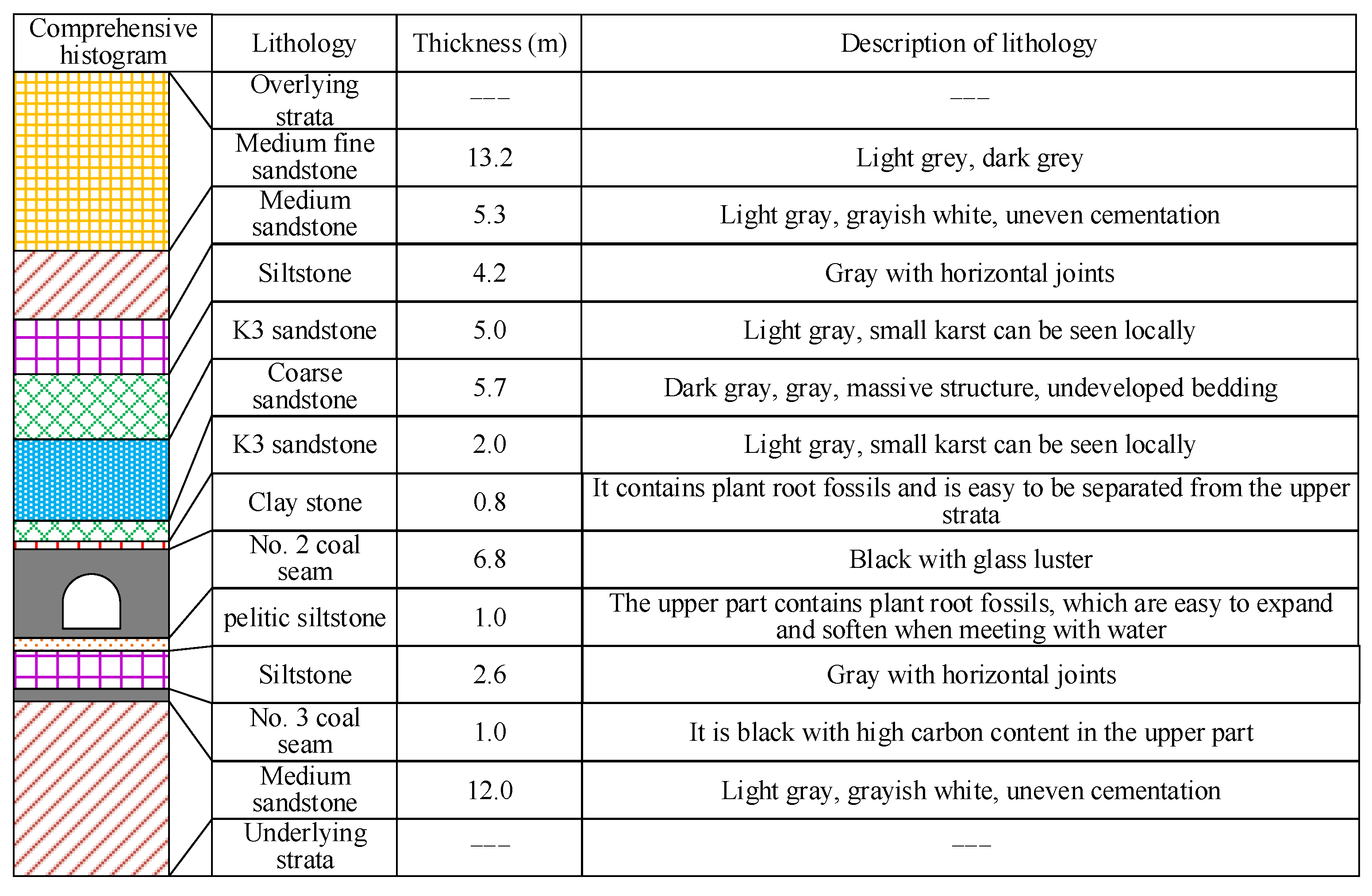
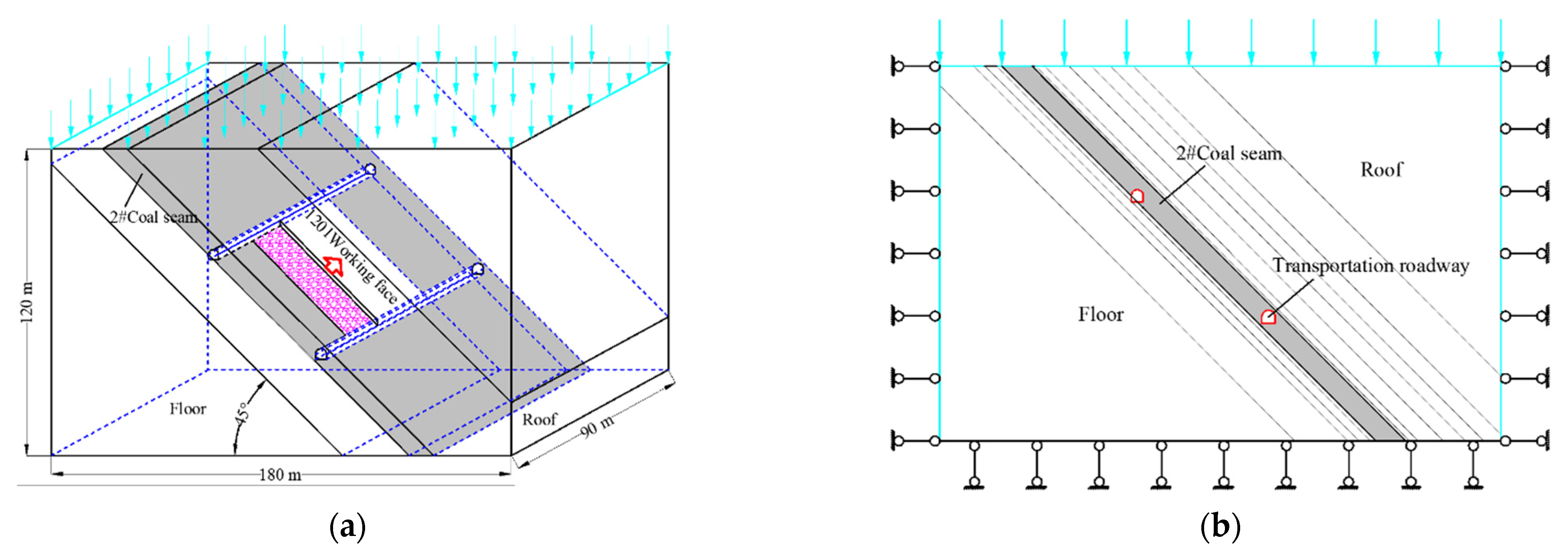
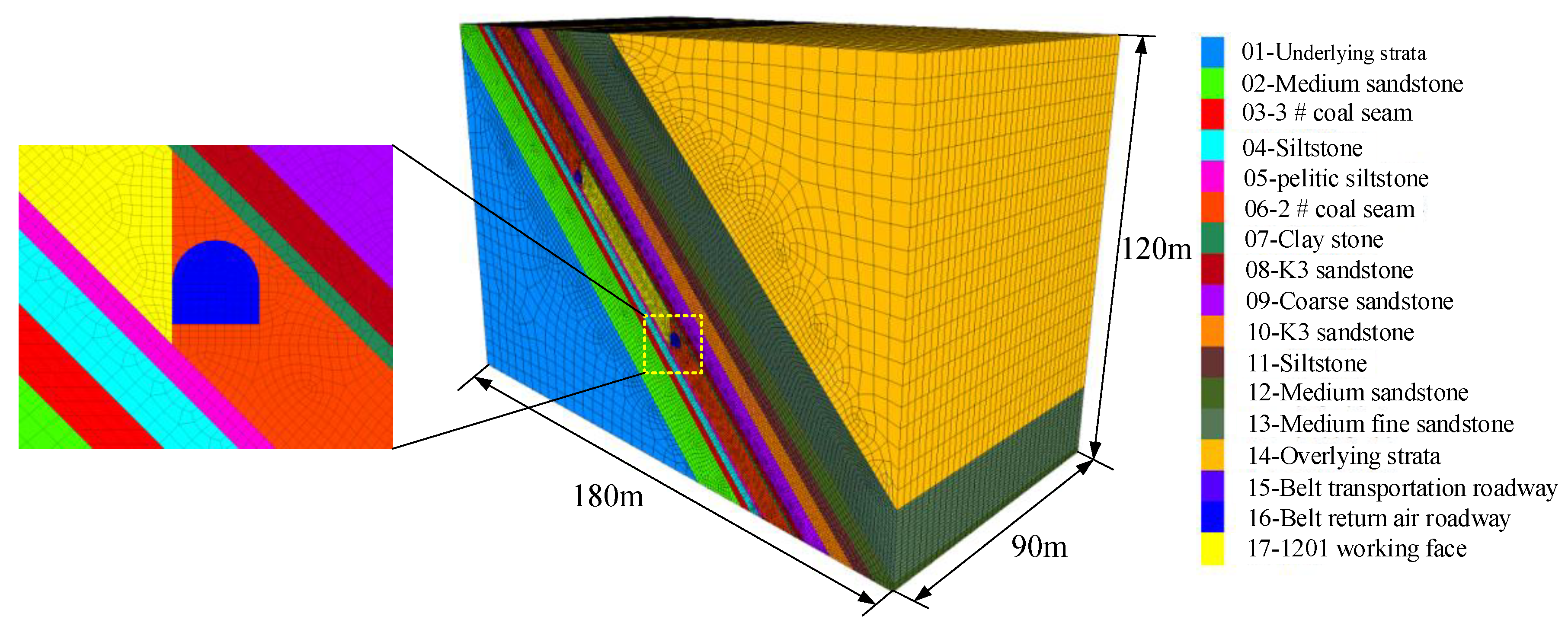

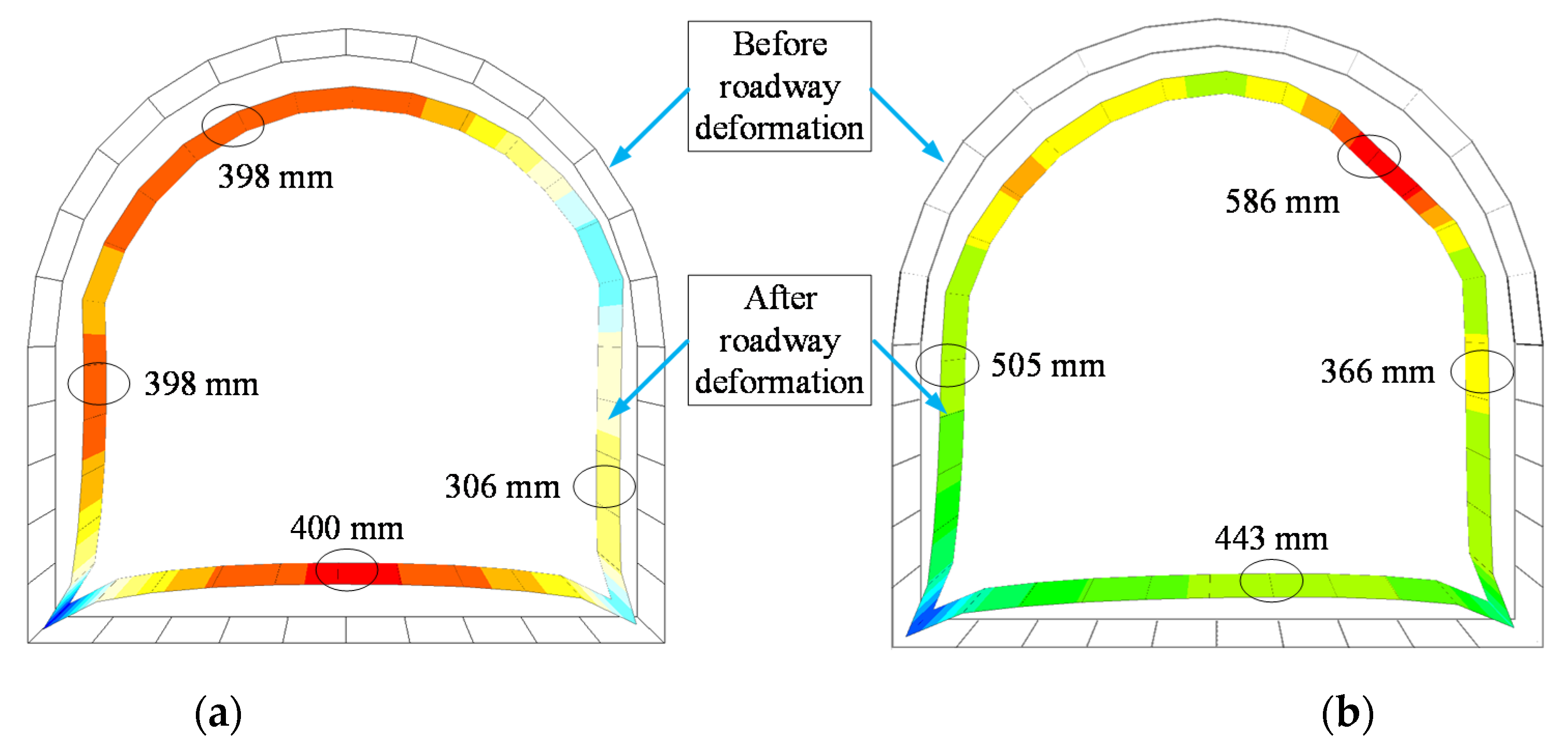
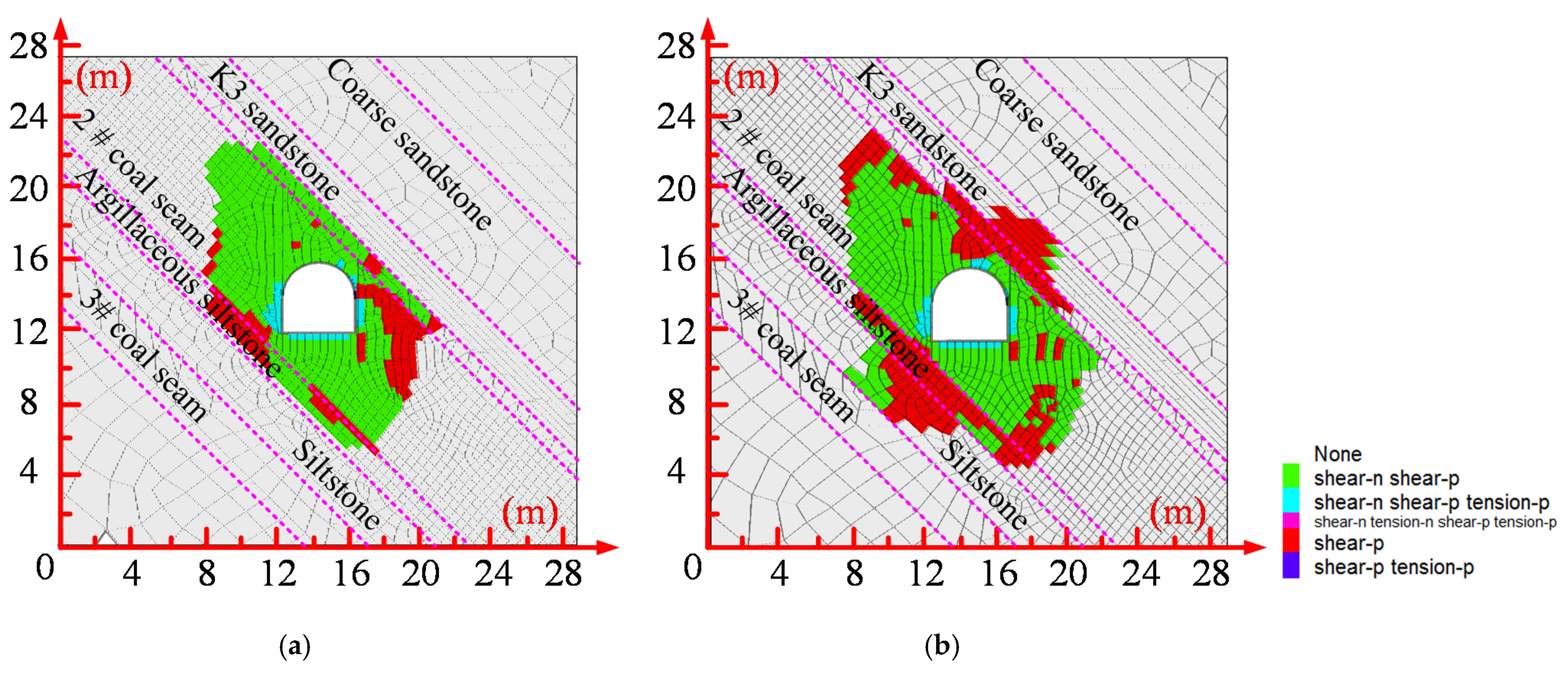

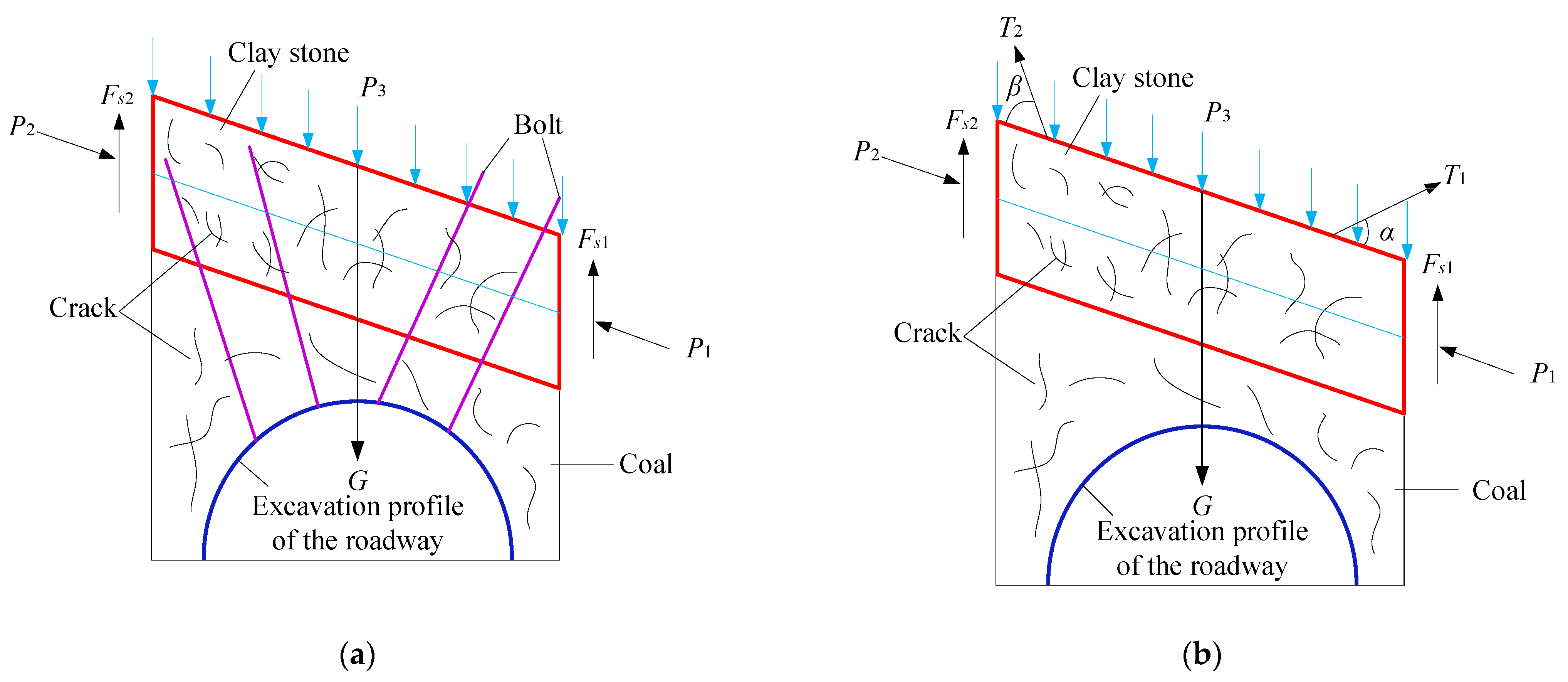
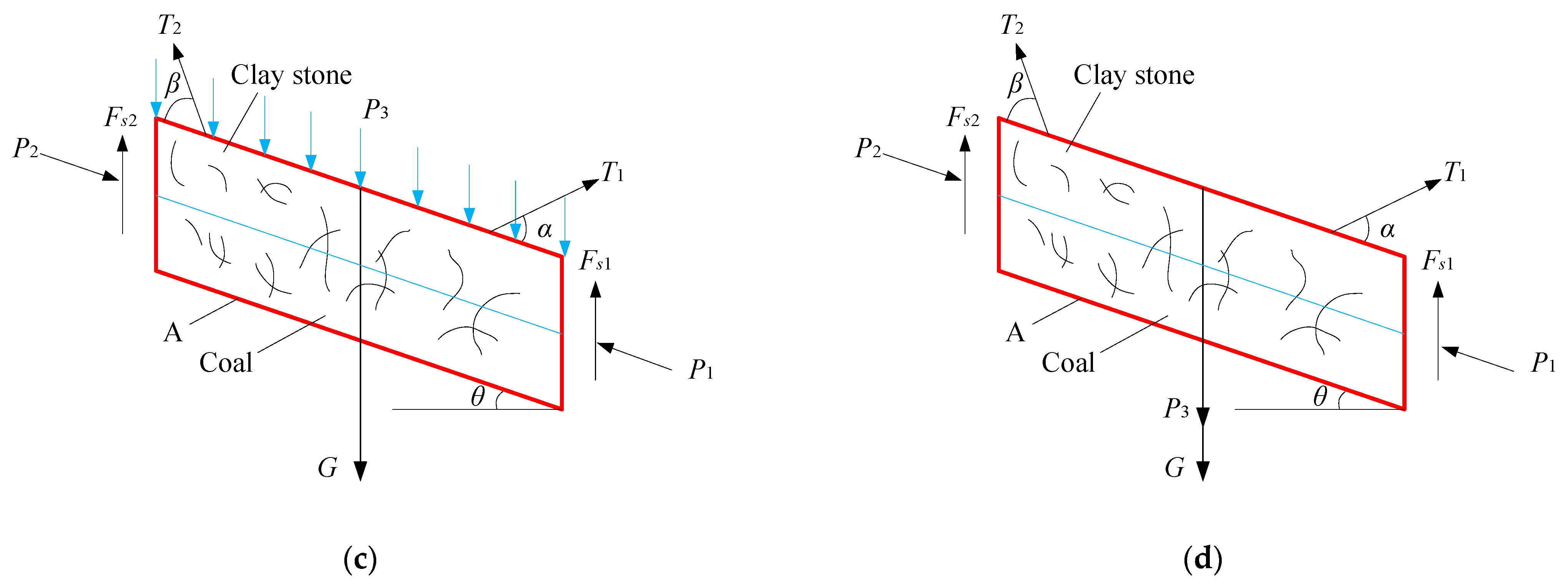

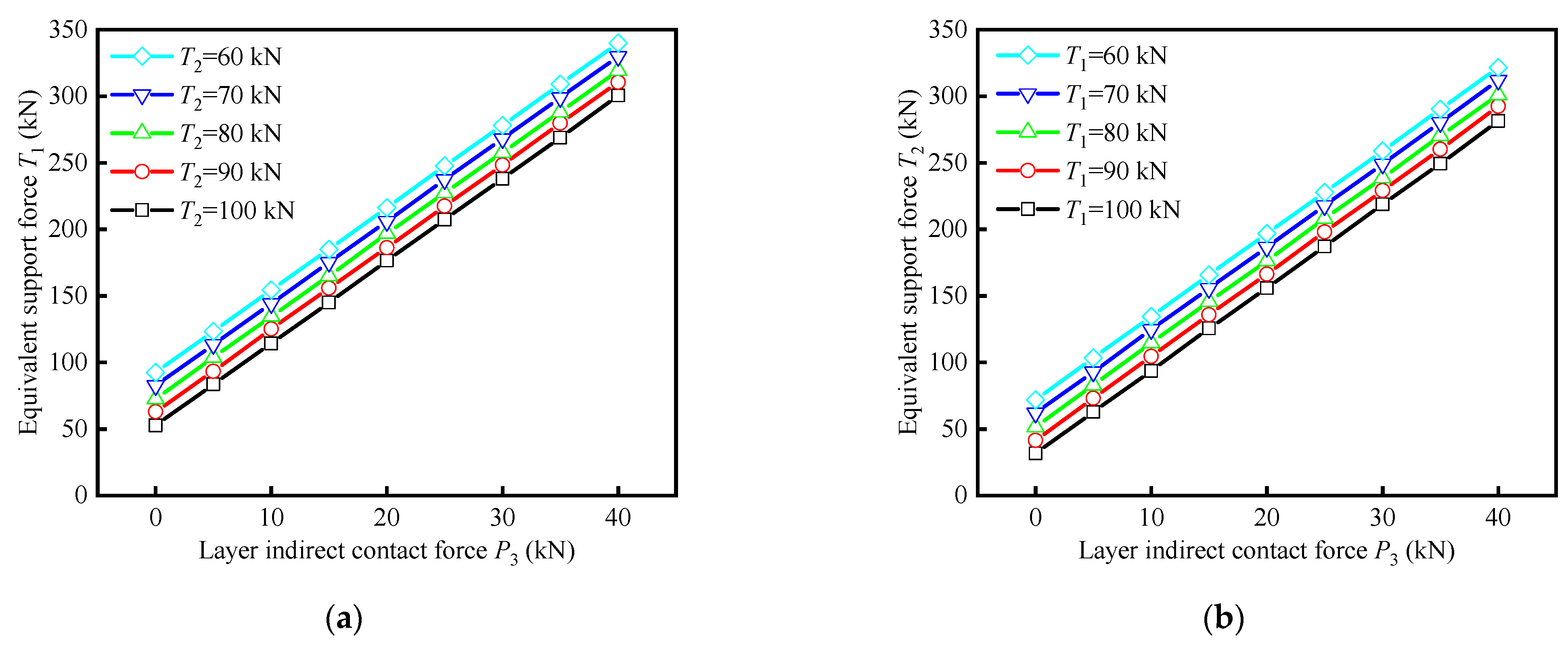
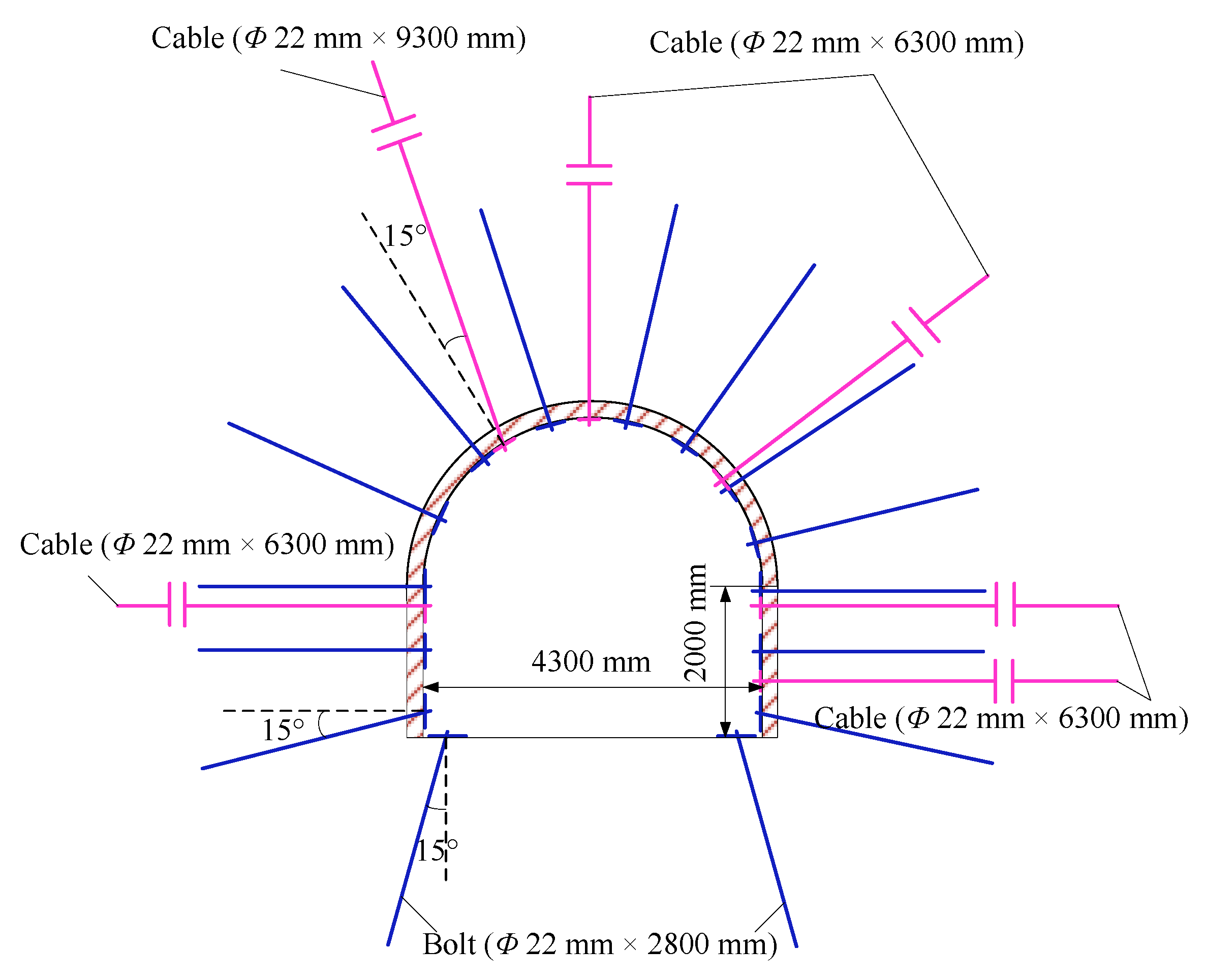
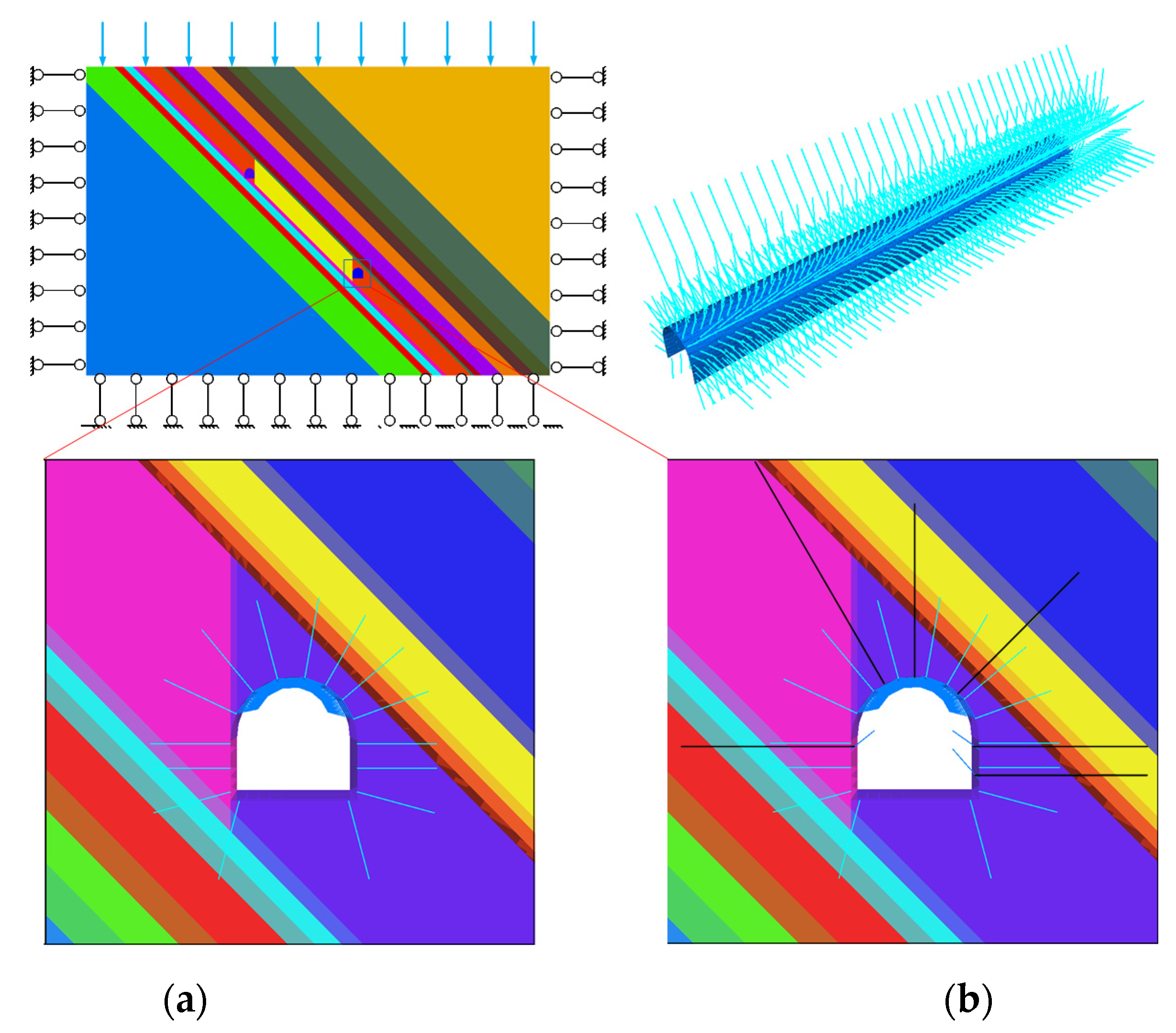
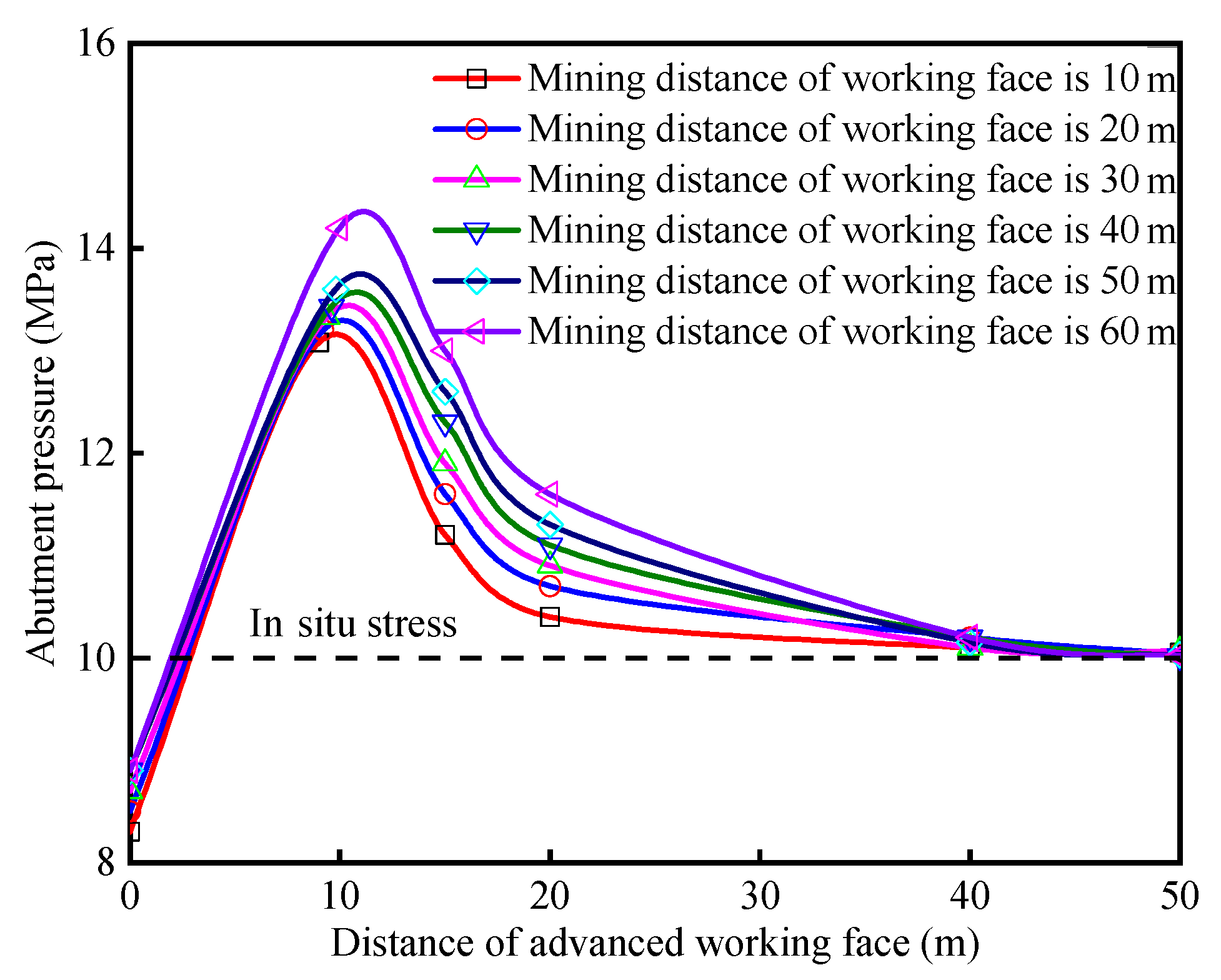
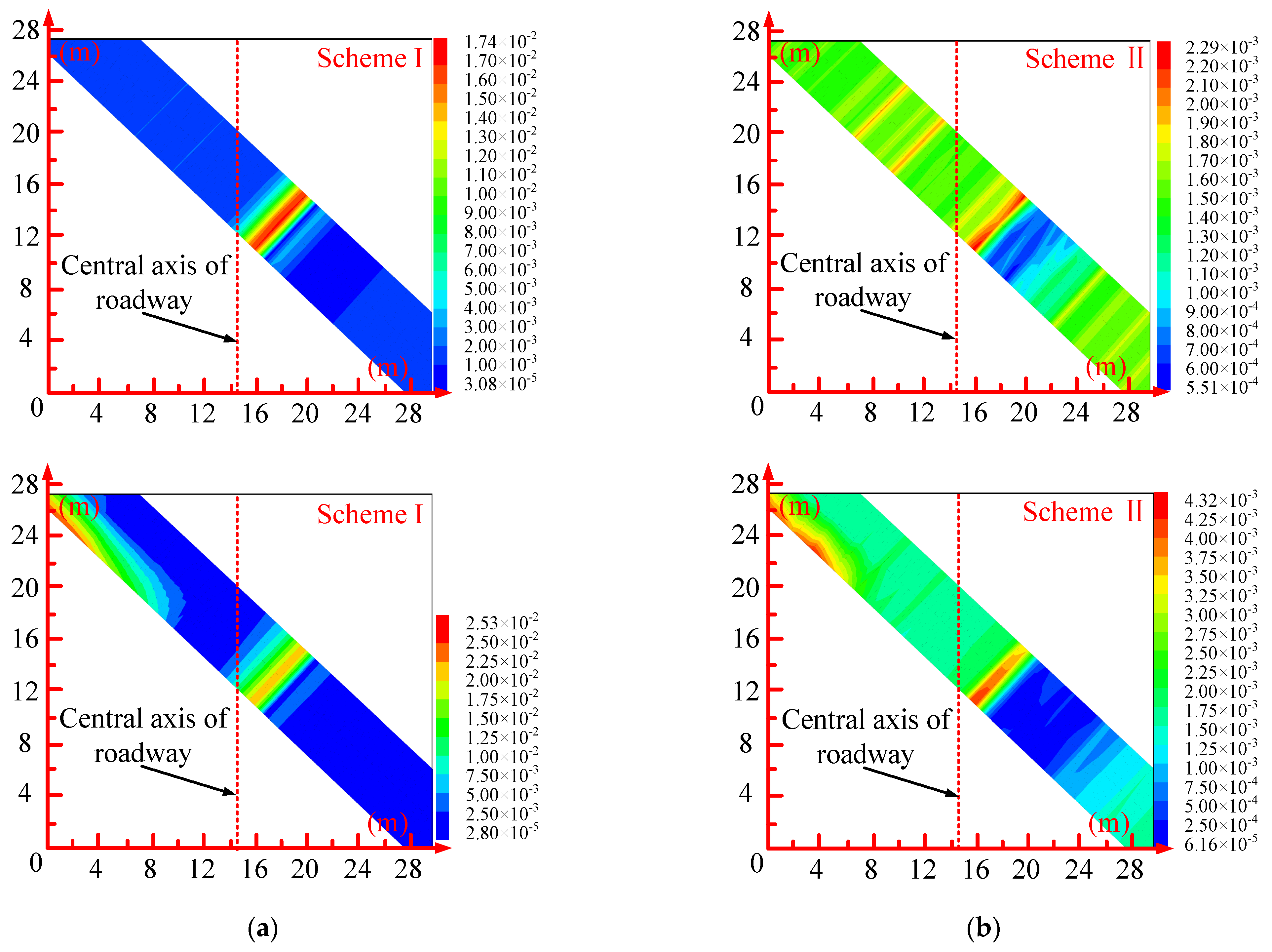
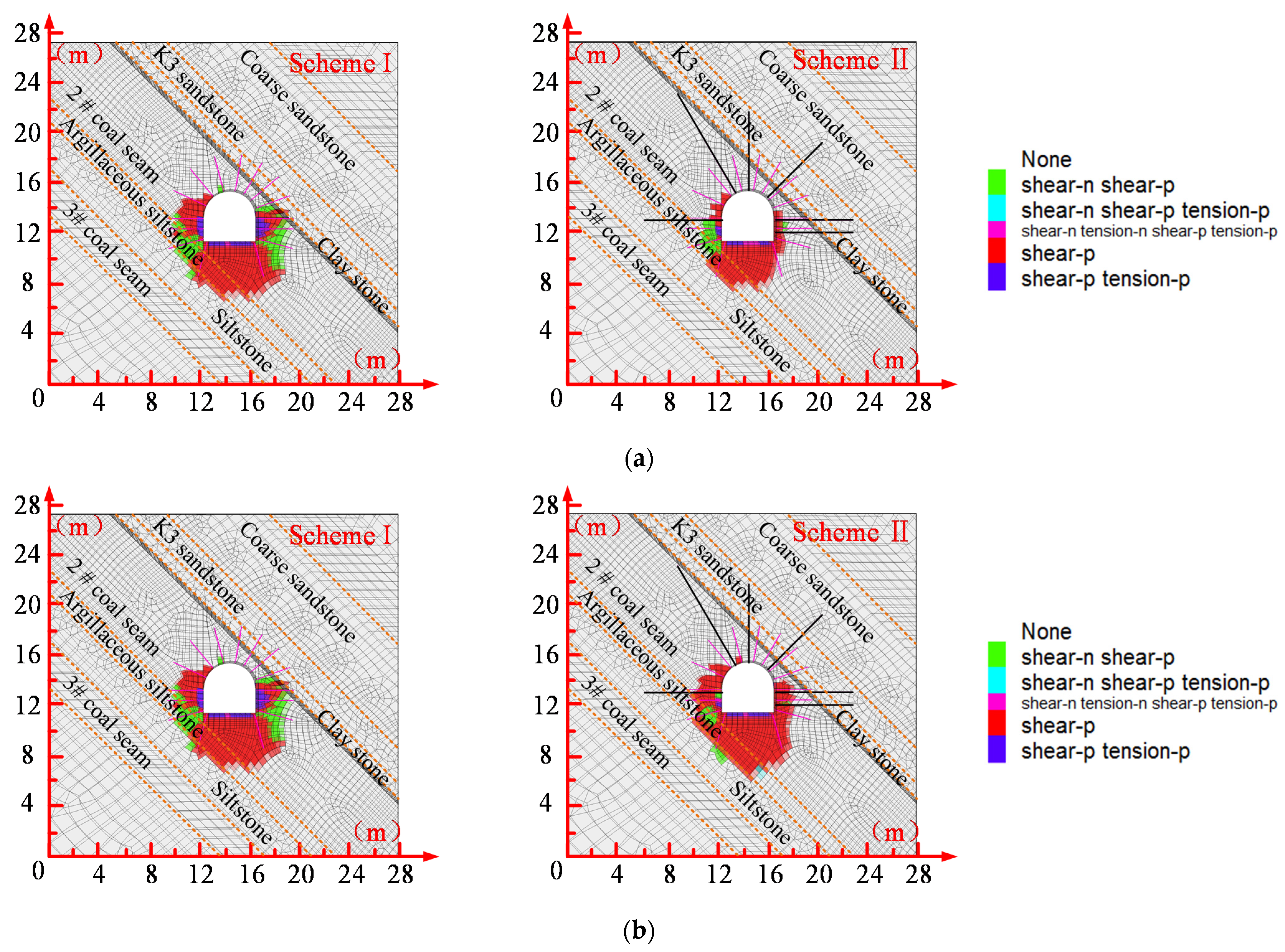

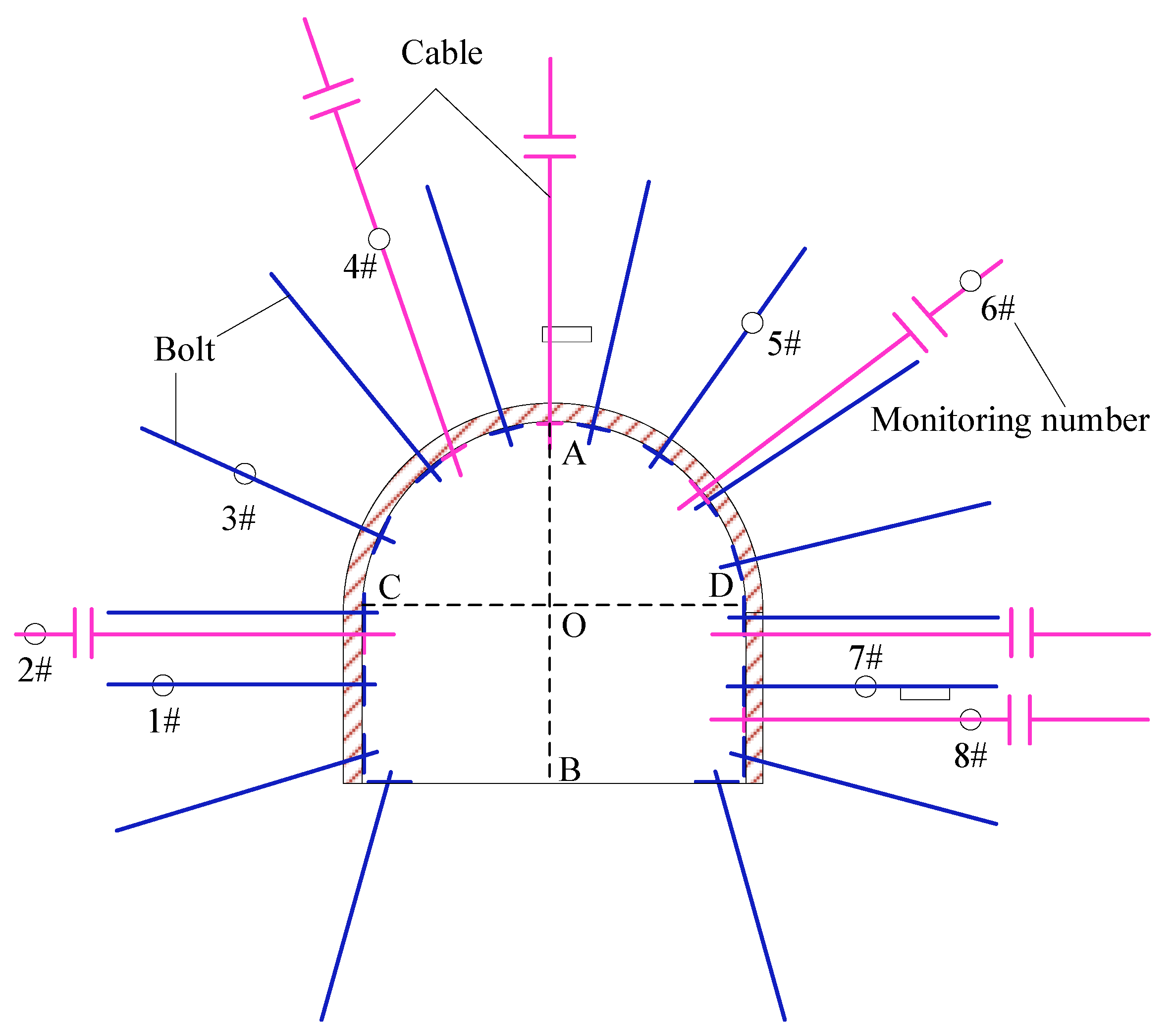
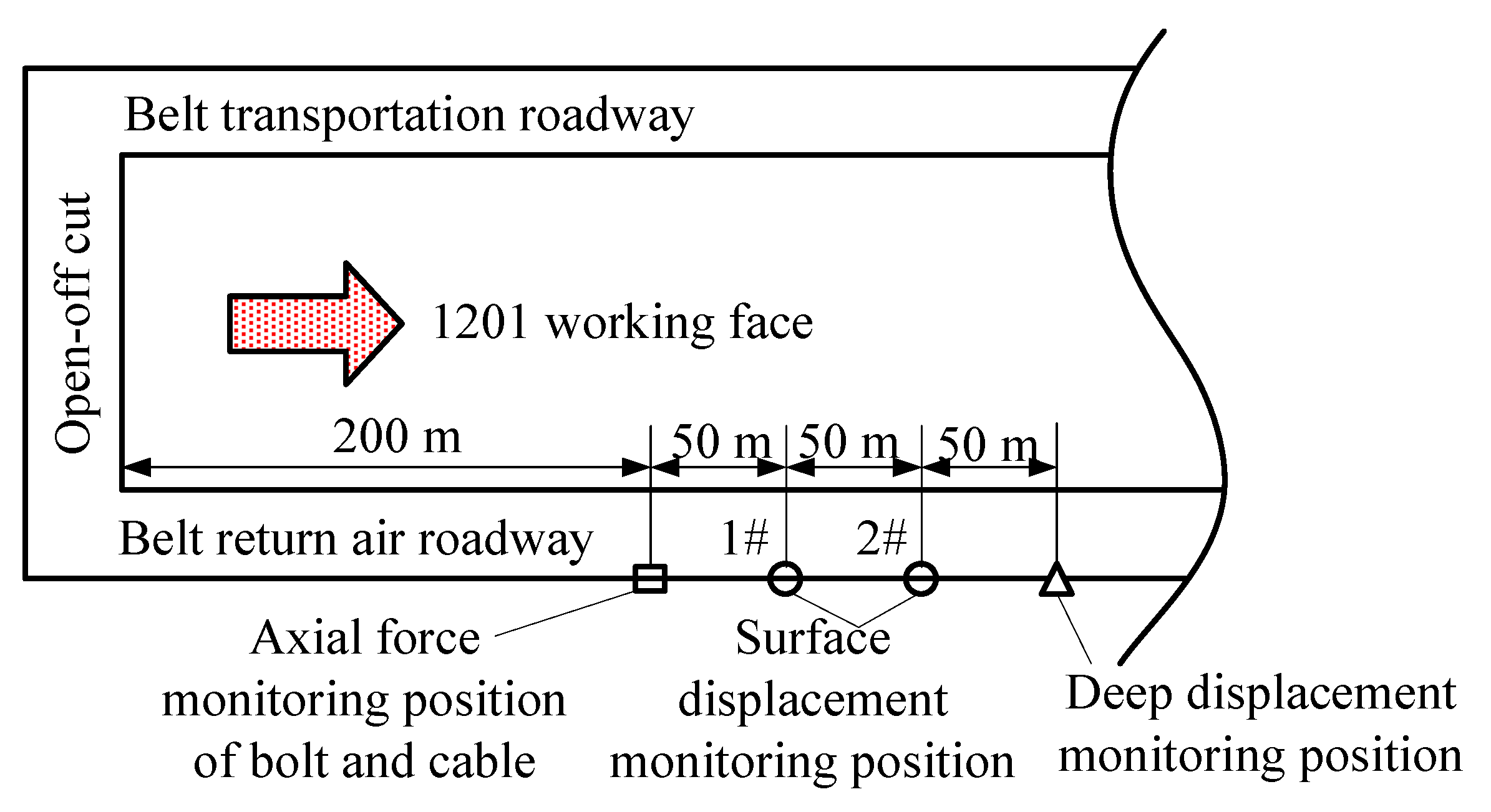

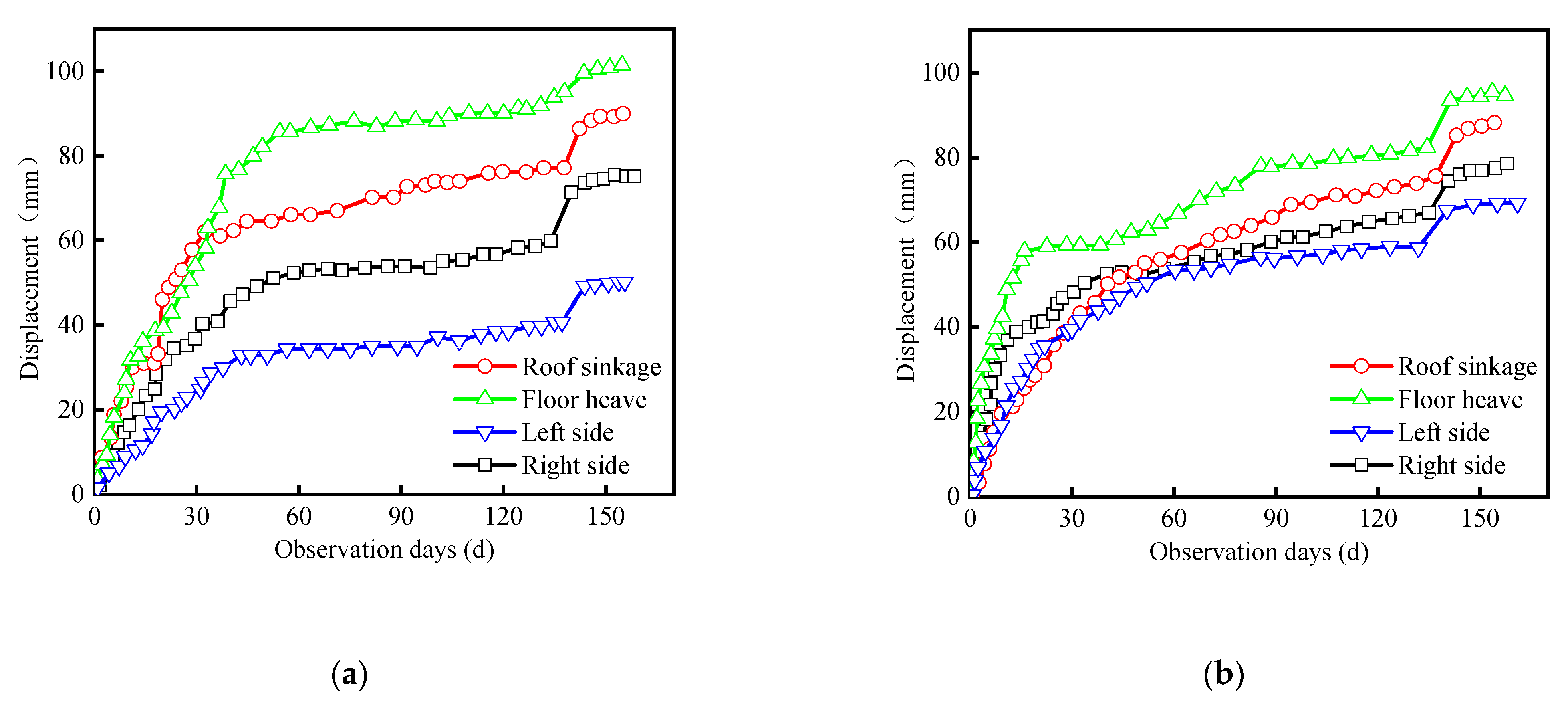
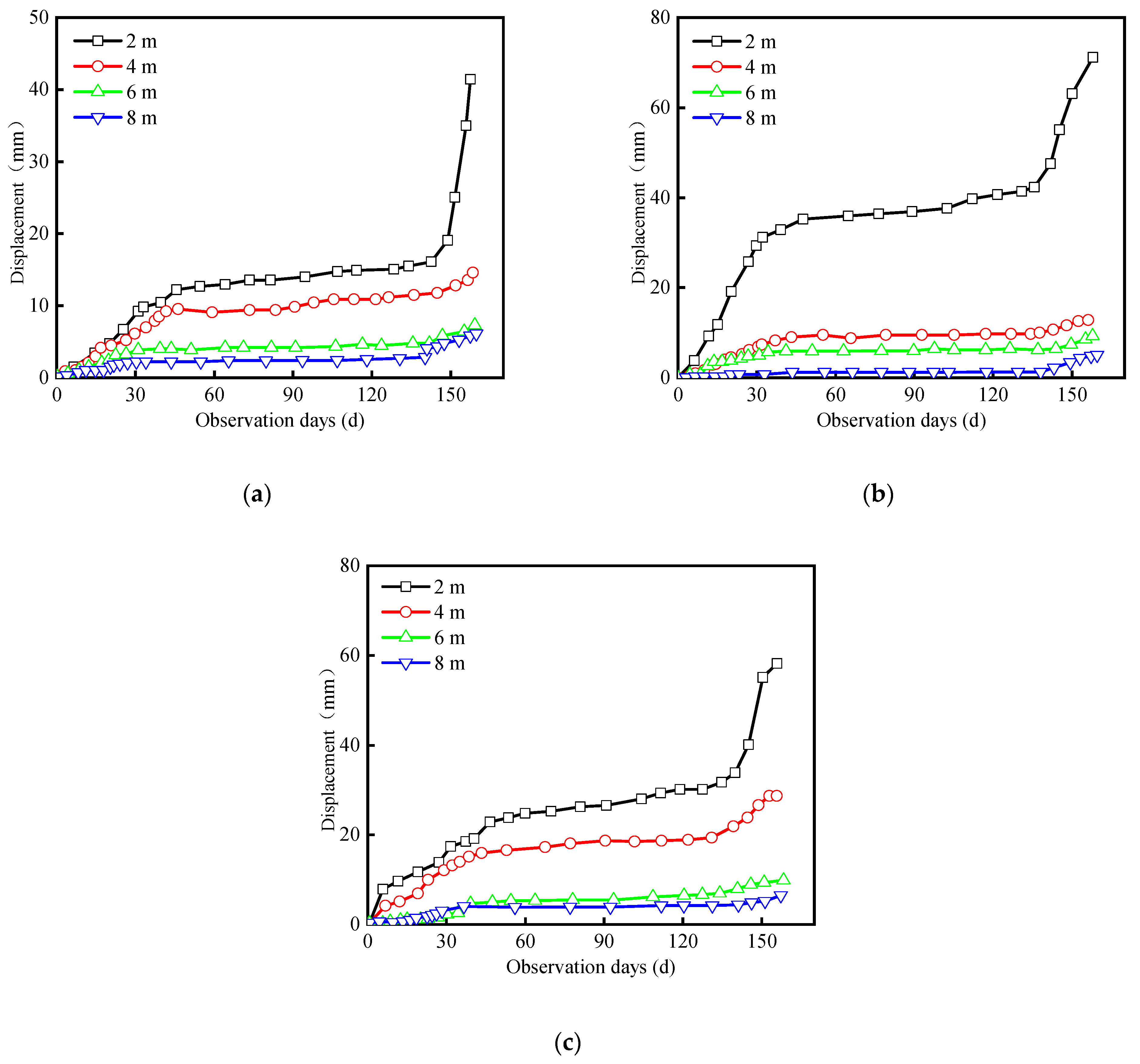
| Stratum Name | Density (kg/m3) | Elastic Modulus (GPa) | Poison’s Ratio | Cohesion (MPa) | Internal Friction Angle (°) | Tensile Strength (MPa) |
|---|---|---|---|---|---|---|
| Overlying rock | 2500 | 3.0 | 0.21 | 2.3 | 34 | 2.6 |
| Medium sandstone | 2680 | 3.9 | 0.18 | 3.3 | 35 | 2.9 |
| Siltstone | 2690 | 2.2 | 0.22 | 1.2 | 33 | 1.4 |
| coal seam | 1400 | 0.79 | 0.31 | 0.2 | 25 | 0.3 |
| pelitic siltstone | 2090 | 1.2 | 0.27 | 0.8 | 28 | 0.5 |
| Clay stone | 1800 | 0.9 | 0.29 | 0.6 | 26 | 0.6 |
| Coarse sandstone | 2400 | 1.4 | 0.22 | 1.2 | 31 | 1.2 |
| K3 sandstone | 2200 | 1.0 | 0.23 | 2.1 | 32 | 1.8 |
| Medium fine sandstone | 2560 | 2.1 | 0.31 | 2.2 | 33 | 2.1 |
| Cross Sectional Area (mm2) | Diameter (mm) | Elastic Modulus (GPa) | Yield Force (kN) | Elongation (%) | Pre-Load (kN) | |
|---|---|---|---|---|---|---|
| bolt | 380.13 | 22 | 2.436 | 190 | 27.5 | 80–90 kN |
| cable | 380.13 | 22 | 200 | 483 | 7 | 300–350 kN |
Publisher’s Note: MDPI stays neutral with regard to jurisdictional claims in published maps and institutional affiliations. |
© 2021 by the authors. Licensee MDPI, Basel, Switzerland. This article is an open access article distributed under the terms and conditions of the Creative Commons Attribution (CC BY) license (https://creativecommons.org/licenses/by/4.0/).
Share and Cite
Wu, P.; Chen, L.; Li, M.; Wang, L.; Wang, X.; Zhang, W. Surrounding Rock Stability Control Technology of Roadway in Large Inclination Seam with Weak Structural Plane in Roof. Minerals 2021, 11, 881. https://doi.org/10.3390/min11080881
Wu P, Chen L, Li M, Wang L, Wang X, Zhang W. Surrounding Rock Stability Control Technology of Roadway in Large Inclination Seam with Weak Structural Plane in Roof. Minerals. 2021; 11(8):881. https://doi.org/10.3390/min11080881
Chicago/Turabian StyleWu, Peng, Liang Chen, Ming Li, Lan Wang, Xufeng Wang, and Wei Zhang. 2021. "Surrounding Rock Stability Control Technology of Roadway in Large Inclination Seam with Weak Structural Plane in Roof" Minerals 11, no. 8: 881. https://doi.org/10.3390/min11080881
APA StyleWu, P., Chen, L., Li, M., Wang, L., Wang, X., & Zhang, W. (2021). Surrounding Rock Stability Control Technology of Roadway in Large Inclination Seam with Weak Structural Plane in Roof. Minerals, 11(8), 881. https://doi.org/10.3390/min11080881







